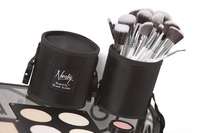Makeup brush

A makeup brush is a tool with bristles, used for the application of make up or face painting. The bristles could be made out of natural or synthetic materials, while the handle is usually made out of plastic or wood. When cosmetics are applied using the appropriate brush they blend better into the skin.
There is a large variety of shapes and sizes of make up brushes, depending on the face area where make up will be applied, the cosmetic product and the wanted result. For example, the shape of the brush tip can be chiseled, straight, angular, round, flat or tapered.
Types of makeup brushes (by area of application)
Face
- Foundation brush - long, flat bristles and tapered tip[1]
- Powder brush - fluffy bristles; soft, full and rounded
- Fan brush - similar to a fan painting brush, used for light touches
- Blush brush - fine bristles and rounded head
- Concealer brush - soft and flat with a pointed tip and a wide base
- Kabuki brush brush - very thick and rounded with a short handle
- Duo fiber multipurpose brush - flat, circular and feathery head
- Mineral powder brush - thick and rounded
- Face Contour Brush - Slanted and rounded for cheekbones
- Face Sponge - Varied Shape, Sponge Texture
Eyes
- Eyeshadow brushes
- basic eyeshadow brush
- crease brush
- lid brush
- contour brush/blending brush
- Angle eyeshadow brush - small, soft and rounded angled tip
- Eyeliner brush - very thin and fine with soft bristles
- Blending eyeshadow brush - long with a round head
- Smudge brush - flat and soft
- Mascara (usually comes with the mascara)
- Eyebrow brush - long, thin with tougher bristles
- Slanted Eyebrow Definer Brush - Stiff and Angeled
- Spiral brush
Lips
- Lipstick brush - fine, soft and tapered
- Lip gloss brush (usually comes with the lip gloss)
Types of makeup brush bristles
Makeup application can alter due to the materials used to create a makeup brush. Bristles of a makeup brush can either be synthetic or natural. The brush itself is important to the application of makeup as it can densely pack on product or loosely pack on product.
Synthetic Bristles
Synthetic bristles are the most common material used in a makeup brush. They are widely found in drugstores and makeup specific stores. The bristles are made out of plastic, and are often dyed to get some color on the bristles. Synthetic bristles are often used with liquid and cream products, as they tend to blend out products more easily and will not absorb product as much compared to a natural bristle brush.[2] Synthetic are cruelty-free. The bristles are usually made from nylon or other synthetic fibers. The longevity of synthetic brushes are usually longer than natural haired bristles as they do not degrade or breakdown and are not as fragile.[3]
Natural Bristles
Natural bristles are made from real hair as opposed to plastic. Many prefer to use natural bristles, since they could be less abrasive to the skin. Although natural bristles are more preferred in the cosmetic industry, the bristles themselves can cause allergic reactions because of the animal fur/hair.[4] Natural bristles may be easier to control the product when blending out or even packing on a product. Natural bristles do have hair cuticles which is why it is easier for the brush to pick up more product and blending it out.[5]
Types of Natural Bristle Brushes[6]
- Sable
- Goat
- Badger
- Pony
- Squirrel
References
- ↑ Retrieved 06/19/2013
- ↑ "Making The Switch: Why Synthetic Makeup Brushes Are Better Than Natural Hair Brushes – Je t'aime by Hotashi". www.hotashi.com. Retrieved 2016-10-27.
- ↑ "The Makeup Brush Buying Guide". Kevin James Bennett. 2013-05-12. Retrieved 2016-11-03.
- ↑ Erdogan, Melodi. "What Kind Of Makeup Brush Should You Use? Here's The Difference Between Synthetic And Natural Brushes". Retrieved 2016-10-20.
- ↑ "A Guide to Makeup Brush Construction - Hair and Makeup Artist Handbook". Hair and Makeup Artist Handbook. 2012-08-31. Retrieved 2016-11-03.
- ↑ Tools, John Galt's. "The Best Makeup Brushes". www.urbanapothecary.com. Retrieved 2016-10-27.